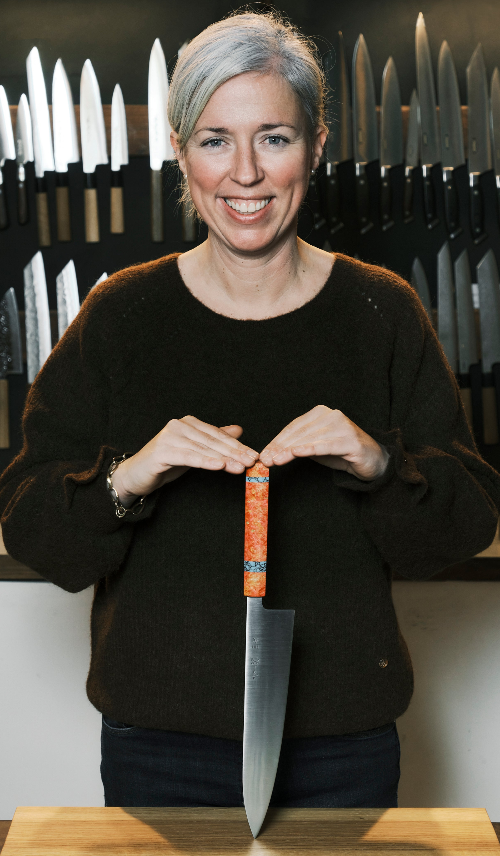A custom knife is created
Sometimes a customer or we ourselves want to make something very special out of a knife. We are thinking here of knives with specially made handles or other modifications - what is broadly referred to as custom work.
In the following, we will take a look at how we at Foodgear build a custom knife. The reason why we make one is typically that a customer, after trying a few different knives in our shop, has found one that cuts perfectly, but perhaps has an ill-fitting or perhaps boring handle for the customer - or that you simply just want something really special. This is therefore a rebuild, but we also receive loose blades from our suppliers in Japan from time to time. In this article we will look at a knife built from a loose blade.

When we build for a customer, we typically start by preparing a working drawing. It gives an idea of where we expect to end up, and the drawing comes with the delivered knife after the work is finished. In this case, the blade is a three-layer hand-forged blade with a core of blue steel - here it is aogami-1. The blade is kurouchi-treated as you know it from e.g. Moritaka . In this case, the handle must be classic octagonal. It must be made of Desert Ironwood knot (olneya tesota), and there must be an inlay of mammoth molar and a few layers of various metals. You often see on specially made knives that they have some form of spacers , as they are called in English. They serve the purpose of giving the knife an aesthetic boost, while they are completely decisive for how the handle should be made in a purely artisanal manner. It may seem strange, but a handle in several parts is significantly easier to make than the completely single, stylish handle in e.g. a Konosuke GS+ , which is made in one single piece.

Before the work really starts, a piece of wood is selected. In this case, the customer wanted Desert Ironwood knot from Arizona, which in our opinion is also among the most beautiful wood in the world. It can also be seen on several that the finest knives we have - e.g. at Nenox and at Laguiole en Aubrac. Above you can see four different pieces that have a lot of play in the wood and varying colors. It is also a very hard type of wood, and this means that later in the process the wood will take a very nice polish.

The wood is initially roughly cut into its octagonal shape on a circular saw with a fine-toothed blade. In this step, the shank is cut approx. 1 to 1.5 mm larger on all conductors than the final measurements should be. A lot of work has to be done freehand afterwards, and therefore there must be some material to remove if misalignments occur during the assembly of the knife. In the picture above, there are handles for two different knives, and although the tones of the wood look different, they actually come from the same block. A brick in a size and quality like the two above costs approx. DKK 600-900 cleared by customs and delivered to the door here in the Kingdom of Denmark. But they are also just beautiful!
When the wood has its basic octagonal shape, and is otherwise cut so that the socket is free, you have to start making room for the blade. In the front part of the knife - the socket - we mill a groove in the wood which ends very close to the tang of the blade (the part of the metal that sits inside the handle). In the second and longer part of the tree, we drill out to the tang. This does not have to be quite as precise as with the socket, as you cannot see the hole when the knife is finished. At the same time, it is quite practical, because the milling cutter cannot cut as deeply as a drill can.



Above you can see partly how we drill out to the tang in the handle, we see how the socket is milled out, and the attentive reader will also see that the socket is milled a little bit asymmetrically. We can afford that, because the stock still has to be shaped after being assembled - and we have material for that, as all parts are intentionally cut a little too big.
The wood is now ready to be assembled with the knife, but we are missing the spacer. If you are crafty, you start with the intermediate layer when building a knife like this. This is because the intermediate layer here consists of several items that must be glued together. However, we start with the main ingredient, a piece of stabilized mammoth tusk.

Above you can see three pieces of mammoth molar. They are all stabilized, which means that air pockets in the material have been filled with plastic, and this means that the material is no longer porous and can withstand processing.

The tooth piece is ground parallel on its two largest surfaces, and then glued together with the metal pieces to be used. In this case copper and tin. Here you can see two spacers for two knives, as we typically build several knives at a time when we make special orders. You can also see that the intermediate layers are assembled with two-component epoxy glue. You could also have assembled the spacers with CA glue, and there are advantages and disadvantages to both. Epoxy is e.g. very heat sensitive, which means that care must be taken when grinding the stock to its final shape afterwards. CA glue hardens very quickly (this is what you know as second glue) and it is not heat sensitive when you sand it. CA glue, on the other hand, is not particularly mechanically strong, and this means that you have to think a lot when working with the spacer in relation to the hole you have to cut in it - because there must be room for the pliers. We usually mill out a groove for the tang, just like with the holken, as it is also gentler than, for example, to drill.
Now we are ready to assemble!
After this, it all gets more fun, and if you've read this far, we're very close to being done. First, you typically make a test assembly, where all the parts are put together without glue, to see if they fit and if the handle will be straight in relation to the blade. We see that, for example on two knives below.

If we are satisfied with the sample collection, we can continue. If not, it must be corrected. It will e.g. appear in the form that the drill has not been drilled far enough down to the tang of the blade, or that the groove in the socket is too small and needs to be widened a bit. The cutter is accurate down to approx. 0.05 mm, so you can make quite fine small adjustments here.

Now the knife is assembled - here glued with epoxy just like the spacers. It should dry for approx. 24 hours to be safe to process. We see here that the intermediate layer is still much larger than the rest of the stock. It can also be seen that the angled end of the stock is now shaped. It has simply been cut diagonally with a saw.

When the handle is dry, it is shaped freehand with a circular sander. You can also use a hand file, and there are advantages and disadvantages to both methods. The disc sander is fast - sometimes too fast. You may therefore end up removing too much material - especially when you cut the slanted sides in the octagonal shape, and you must also take care that the intermediate layer does not get too hot - especially if it contains highly heat-conducting metals such as copper. In the picture above, we see a knife that has just been shaped on the disc sander, and then sharpened with finer sandpaper by hand. We start with grit 320, and continue with 400, 600 and 1000. We then polish the handles with an electric polisher.


Now the knives are virtually finished, after which they are typically hand-sharpened on very fine whetstones before they are finally delivered to the customer. Alternatively, they are photographed and posted on the webshop.




Leave a comment
This site is protected by hCaptcha and the hCaptcha Privacy Policy and Terms of Service apply.